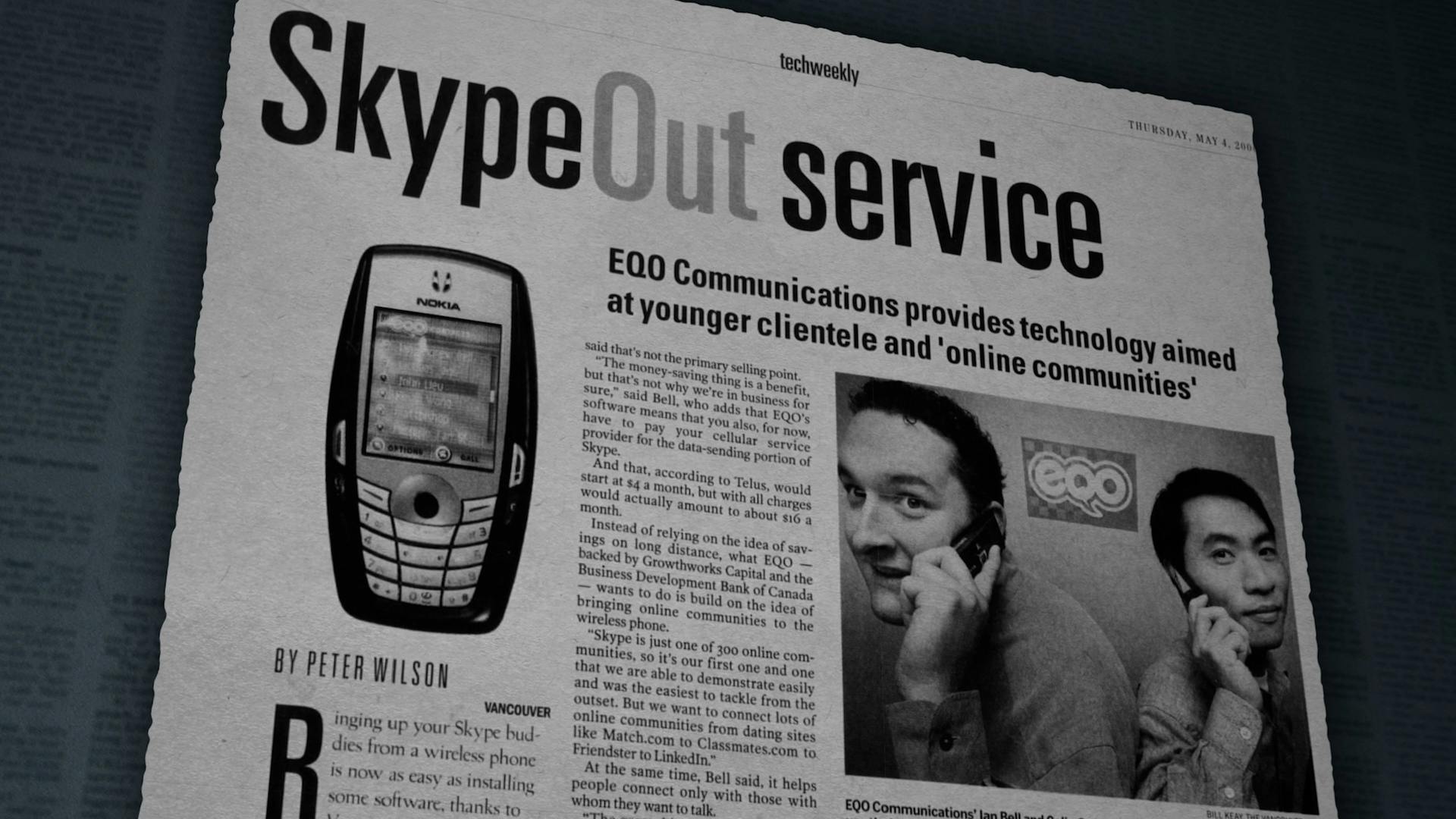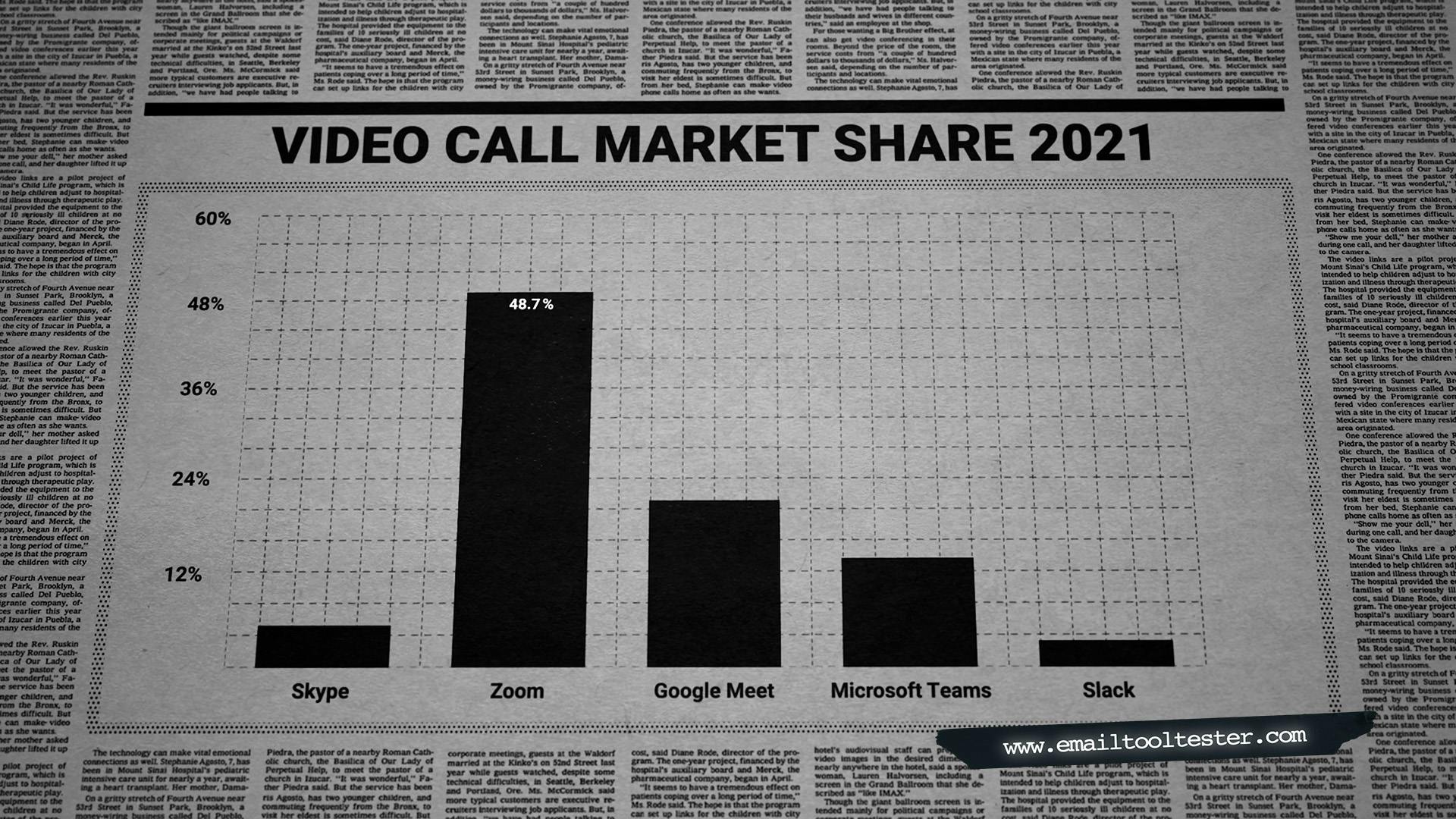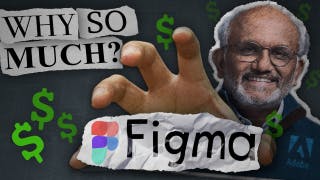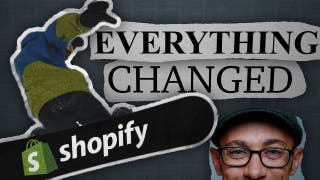
How Skype blew a 10-year lead to Zoom
Video calls have become an essential component of the workday. You can strike up a conversation with anyone in the world with just a few clicks. Sales pitches, webinars, team meetings… imagine if video calls didn’t exist and you had to communicate strictly through email…
Fortunately you don’t, and whether it’s WebEx, Google, or Microsoft I’m sure virtual communication is in your day-to-day. But one company seems to be more prevalent than the rest.
Zoom dominates nearly half of the videoconferencing market. In the past few years you’ve had a Zoom happy hour, watched a Zoom reunion, and definitely suffered from Zoom fatigue. So why does Zoom get the biggest piece of the pie?
At the beginning of 2020, Skype controlled 32.4% of the market compared to Zoom’s 26.4%. But, by the following year, Skype dropped to only 6.6%. At this point, I don’t want anyone Skyping benjaminskywalker94… but if you think your old username is better, let me know.
In such an opportune moment for this industry, where did Skype go wrong? And what did Zoom get so right? In this video we’ll walk through how the industry was formed, the early pioneers, and how Zoom capitalized on the mistakes of Skype. I’m Ben Hillman, and this is Verticals.
Lessons from the Top
Videoconferencing has forever changed the way we work and communicate across the globe, both professionally and personally. But, what this story teaches us is that just because a product or service already exists and even dominates an industry, it doesn't mean someone else can’t or won’t come in with the same idea and knock them off their throne.
Eric Yuan is the example of taking an existing product, making it better, and leaving the competition (even with a 10-year lead) in the dust. He did that because he recognized the value of videoconferencing and then listened intently to what customers actually wanted and needed to make their experience better. Skype’s downfall was that they lost sight of providing the best experience, instead focusing on the bells and whistles that no one was even asking for.
Never rest on your laurels
Don't let any recent success make you complacent in your future efforts, or take your focus away from continuing to improve your core functionality. Though you want to consistently add value to your product or service, you need to ensure the core functionality is always performing optimally. Otherwise, any added features are futile.
Get up close and personal with your customers
Actively listen to and communicate with your customers. Your product development and added features should be based your customer's feedback. If you're not adding value and improving their experience, they will go elsewhere.
Freemium works
Freemium is a business model in which a company offers basic or limited features at no cost and then charges a premium for supplemental or advanced features.
Remember that freemium is an acquisition strategy and provides the ability to reach more customers as anyone can access your service for free. As long as your core functionality is providing a strong and valuable experience, and your features further improve and facilitate your customers' lives, they will likely turn into paying users.
Background
In order to set the stage for Zoom’s dominance, it’s important to understand the problem Zoom solves. Face-to-face communication is crucial because it allows you to read body language and nonverbal cues. Effectively, it gives you a better understanding of what someone is trying to communicate by combining multiple senses: sight and sound.
Videoconferencing (or videotelephony) refers to connecting and communicating via video and audio in real time. Over a hundred years ago, a typical white-collar working day meant going into an office, sitting at a desk, and speaking and interacting with coworkers in the same building. To communicate with someone face-to-face you had to get yourself up and swing by their desk (it was tough work!). You could communicate in real time with a phone call, but this could be cost prohibitive and offered no visual component… In 1927 all of that was about to change.

Then Secretary of Commerce, Herbert Hoover, gave a brief speech to an audience in New York City on a Thursday afternoon. Only, Herbert Hoover wasn’t in New York city. He wasn’t even shouting from a megaphone across the river in New Jersey. No. Herbert Hoover had just conducted the first video call from over 200 miles away while he sat in Washington D.C. at a setup developed by the American Telephone and Telegraph Company (or AT&T-you may be familiar with them).
This demonstration proved that visually connecting with someone over a great distance was possible… but a lot still needed to be figured out. Not seen during Hoover’s speech was the room full of cables, the network installed in between, and the constant iterations required to make this possible. Over the next several decades the groundwork had to be laid to take video conferencing from the bureaucrat to the board room.
Infrastructure was built… the technology was honed in… In the 1990s, the internet arrived and personal computer ownership skyrocketed. As the internet grew, the world shrunk, but no one seemed to crack the code on face-to-face communication. It was possible, but cost was still proving to be an issue. Several startups capitalized on this opportunity but it wasn’t until the early 2000s that videoconferencing had a breakthrough.
Early Leaders
In the country of Estonia, Kazaa founders found themselves in a bit of trouble as their company had become one of the largest file-pirating sites in the world. Kazaa made it possible to send files from one computer to another without an intermediary. They had the idea to use this method to make voice calls cheaper. So they started a new company: Skype entered the market.

It was first released in 2003 as a voice-over IP service to make free computer-to-computer calls, or reduced-rate calls. Two years later they introduced videotelephony and in the same year were acquired by eBay, a sale valued at $2.5 billion. In 2011 it was again acquired, this time by Microsoft Corporation for $8.5 billion.
By 2012 they accounted for 167-billion minutes of cross-border voice and video calling in a year. It was the number one downloaded video app and the sixth most downloaded app of the entire 2010s beating out the likes of TikTok, YouTube, and Twitter. Skype had become a verb. Skype was how you connected with people all over the world. It revolutionized communication in business and for the world in general.
But on the tail of Skype’s success was a new competitor that was about to enter the arena…
In 2011, an engineer named Eric Yuan founded a company called SaaSbee. Eric began his career at WebEx and during his time there, he discovered something that would eventually lead him to leave. His discovery? Too many unhappy customers.
After talking to customers and asking for direct feedback he learned that customers needed one unified solution. They needed a cloud-based conference room solution with good voice-over IP and video quality. Knowing WebEx was not designed for that, Eric left.
He took that knowledge and built exactly what they demanded. By 2012 SaaSbee acquired its first customer and by 2013, it reached one-million participants worldwide. Today, you know that company as Zoom.
So, what was the key difference that made Zoom soar and Skype plunge?
Reasons for success
When it comes to Skype, Microsoft’s adamant intent to make Skype compete with everyday communication apps, completely backfired. Priority was given to Microsoft Teams which included video conferencing as a portion of the product. Skype succumbed to feature creep and consistent redesigns. Users spoke of long load times, ad-filled browser windows, and updates before a meeting.
Skype brought the world closer together but through multiple sales and leadership changes, no one was listening to what customers were saying. Where Skype failed is precisely where Zoom succeeded.
Zoom runs with the singular focus to make video calls as frictionless as possible. They have a unifying leader in Eric Yuan. He ensures that his product is evolving based on customer needs, even personally getting into Twitter replies to ensure users are satisfied. In order to bring people closer, you have to go to where people are.
Additionally, Zoom’s success can be credited to the way it monetized the product: freemium. Freemium is a business model in which a company offers basic or limited features at no cost and then charges a premium for supplemental or advanced features. This allows anyone to access the service.
Anyone can connect to a 40-minute meeting for free. Once users require longer meetings, they’re happy to pay the $15 a month per license.
Another element to Zoom’s success is the initial focus on telemedicine and education. Zoom entered into agreements with several universities like Kansas State, Northern Iowa, and Ottawa offering educational licenses. This allowed Zoom to focus on one or two markets and then expand into others when the time was right.
Talking to customers, simplified use, freemium, and landing and expanding are the ingredients that lead to Zoom’s success. After the IPO in April of 2019 Zoom was valued at $9.2 billion… By focusing on making it as easy as possible to communicate face-to-face, Zoom was well positioned to explode… as luck would have it, that opportunity was right around the corner…
In 2020, a global pandemic swept over, and life as we knew it, seemed to change overnight. Suspended travel, at-home schooling, and working from home all became standard. And most major video conferencing companies benefited. Well… some more than others. Zoom saw its market share go from 26.4% in 2020 to 48.7% in 2021, more than twice the market share of Skype and Microsoft Teams combined.

Skype fell victim to being the hot product. Microsoft effectively acquired it in hopes that users would transfer over to their native solutions. Focus shifted to redesign the look of the product as well as adding features no one was begging for like emojis. Because of this, the core functionality of reliable video calling suffered, which made Skype vulnerable and ultimately led to its downfall.
Summary
Business has benefited greatly from videoconferencing. As many as 76% of individuals use video calls to work remotely allowing for less commuting, less travel, and more time spent being productive. It has changed the way we work by bringing us closer. Face-to-face communication becomes easier and easier with every Zoom update.
But as with anything, just as there are benefits, there are downsides. There is still a disconnect between videotelephony and in-person communication. Excessive close-up eye contact, seeing yourself constantly, a reduction in mobility, and an increase in cognitive load contribute to what academics are calling “Zoom Fatigue.”
If Eric Yuan wants to avoid the same fate as Skype, he needs to ensure Zoom is prepared for these technological leaps.
Companies are starting to focus on bringing the experience closer to real life. In 2021, Google announced Project Starline. The tech is reminiscent of the video booths of yesteryear. Users can see each other via a screen utilizing 3D imagery on a 3D display without needing to wear a headset. It’s still a long way from becoming a daily reality, but it’s experiments like this that will bring video calling to the next level.
A company that wishes to compete with Zoom at the very least has to rise to the floor of what Zoom is capable of. The focus has to be on listening to customers and getting the closest to unencumbered face-to-face communication. What company do you think that will be? Let us know what you think in the comments down below. From Paddle Recur, I’m Ben Hillman, and I’ll see you next time.
Do us a favor?
Part of the way we measure success is by seeing if our content is shareable. If you got value from this episode and write up, we'd appreciate a share on Twitter or LinkedIn.
1
00:00:00,000 --> 00:00:01,260
Skype concerned.
2
00:00:01,260 --> 00:00:02,640
Everybody's gonna use Zoom!
3
00:00:02,640 --> 00:00:05,040
Video conferencing is the new normal.
4
00:00:05,040 --> 00:00:10,140
Video calls have become an essential component
of the work day. You can strike up a conversation
5
00:00:10,140 --> 00:00:16,200
with anyone in the world with just a few clicks.
Sales pitches, webinars, team meetings. Imagine
6
00:00:16,200 --> 00:00:21,220
if video calls didn't exist and you had to
communicate strictly through email. Oof.
7
00:00:22,080 --> 00:00:24,720
Fortunately, you don't. And whether it's Webex,
8
00:00:24,720 --> 00:00:29,460
Google, or Microsoft, I'm sure virtual
communication is in your day-to-day.
9
00:00:30,300 --> 00:00:35,460
But one company seems to be more prevalent
than the rest. Zoom dominates nearly half
10
00:00:35,460 --> 00:00:39,180
of the video conferencing market. In
the past few years, you've had a Zoom
11
00:00:39,180 --> 00:00:43,740
happy hour, watched a Zoom reunion, and
definitely suffered from Zoom fatigue.
12
00:00:43,740 --> 00:00:48,600
But why does Zoom get the biggest piece of the
pie? While at beginning of 2020 Skype controlled
13
00:00:48,600 --> 00:00:55,200
32.4% of the market compared to Zoom's 26.4. But
by the following year, Skype dropped to only 6.6.
14
00:00:56,220 --> 00:01:00,180
At this point, I don't want anyone Skyping
BenjaminSkywalker94, but if you think your
15
00:01:00,180 --> 00:01:03,600
old username is better than mine, let
me know in the comments down below.
16
00:01:03,600 --> 00:01:09,240
In such an opportune moment for this industry,
where did Skype go wrong? And what did Zoom get
17
00:01:09,240 --> 00:01:14,400
so right? In this video, we'll walk through how
the industry was formed, the early pioneers,
18
00:01:14,400 --> 00:01:20,400
and how Zoom capitalized on the mistakes of
Skype. I'm Ben Hillman, and this is Verticals.
19
00:01:24,840 --> 00:01:29,640
In order to set the stage for Zoom's dominance,
it's important to understand the problem that Zoom
20
00:01:29,640 --> 00:01:34,980
solves. Face-to-face communication is crucial
because it allows you to read body language
21
00:01:34,980 --> 00:01:40,080
and non-verbal cues. Effectively, it gives you a
better understanding of what someone is trying to
22
00:01:40,080 --> 00:01:46,440
communicate, by combining multiple senses, sight
and sound. Video conferencing, or videotelephony,
23
00:01:46,440 --> 00:01:51,900
refers to connecting and communicating via video
and audio in real-time. Over a hundred years ago,
24
00:01:51,900 --> 00:01:56,040
a typical white-collar working day meant
going into an office, sitting at a desk,
25
00:01:56,040 --> 00:02:00,180
and speaking and interacting with coworkers
that were in the same building or nearby.
26
00:02:00,720 --> 00:02:02,880
To communicate with someone face-to-face you had
27
00:02:02,880 --> 00:02:07,380
to get yourself up and swing by their
desk. I know, it was really tough work.
28
00:02:07,380 --> 00:02:12,180
You could communicate in real-time with a phone
call, but this could be cost-prohibitive and
29
00:02:12,180 --> 00:02:18,480
offered no visual component. In 1927, all of that
was about to change. Then secretary of commerce,
30
00:02:18,480 --> 00:02:22,800
Herbert Hoover, gave a brief speech to an
audience in New York City on a Thursday afternoon,
31
00:02:22,800 --> 00:02:28,680
only Herbert Hoover wasn't in New York City.
He wasn't even shouting from a megaphone across
32
00:02:28,680 --> 00:02:34,020
the river in New Jersey. No, Herbert Hoover
had just conducted the first video call from
33
00:02:34,020 --> 00:02:39,780
over 200 miles away while he sat in Washington
D.C. He sat at a setup developed by the American
34
00:02:39,780 --> 00:02:45,600
Telephone and Telegraph Company, or AT&T. You
may be familiar with them. This demonstration
35
00:02:45,600 --> 00:02:50,640
proved that visually connecting with someone
over a great distance was possible, but a lot
36
00:02:50,640 --> 00:02:55,080
still needed to be figured out. Not seen during
Hoover's speech was the room full of cables,
37
00:02:55,080 --> 00:02:59,460
the network installed in between, and the
constant iterations to make this possible.
38
00:03:00,060 --> 00:03:04,560
Over the next several decades, the groundwork had
to be laid to take video conferencing from the
39
00:03:04,560 --> 00:03:10,500
bureaucrat to the boardroom. Infrastructure was
built, the technology was honed. In the 1990s,
40
00:03:10,500 --> 00:03:13,800
the internet arrived and personal
computer ownership skyrocketed.
41
00:03:13,800 --> 00:03:15,120
Can you explain what internet is?
42
00:03:15,120 --> 00:03:20,280
As the internet grew, the world shrunk.
But no one seemed to crack the code on
43
00:03:20,280 --> 00:03:23,280
face-to-face communication. It was possible, sure,
44
00:03:23,280 --> 00:03:28,200
but cost was still proving to be an issue.
Several startups capitalized on this opportunity,
45
00:03:28,200 --> 00:03:32,640
but it wasn't until the early 2000s that
video conferencing had a breakthrough.
46
00:03:33,360 --> 00:03:37,020
In the country of Estonia, Kazaa founders
found themselves in a bit of trouble,
47
00:03:37,020 --> 00:03:41,040
as their company had become one of the
largest file pirating sites in the world.
48
00:03:41,040 --> 00:03:44,760
900 million files are currently being-
49
00:03:44,760 --> 00:03:46,020
Whoa.
... on Kazaa.
50
00:03:46,020 --> 00:03:51,360
Kazaa made it possible to send files from one
computer to another without an intermediary. They
51
00:03:51,360 --> 00:03:55,860
had the idea to use this method to make voice
calls cheaper, so they started a new company.
52
00:03:56,700 --> 00:04:01,560
Skype entered the market. It was first released
in 2003 as a voice over IP service to make free
53
00:04:01,560 --> 00:04:06,600
or reduced-rate computer-to-computer calls. Two
years later, they introduced videotelephony,
54
00:04:06,600 --> 00:04:11,940
and in the same year, they were acquired
by eBay, a sale valued at $2.5 billion.
55
00:04:12,840 --> 00:04:18,840
And then in 2011, they were acquired again by the
Microsoft Corporation for another $8.5 billion.
56
00:04:19,440 --> 00:04:24,780
By 2012, Skype accounted for 167 billion
minutes of cross-border voice and video
57
00:04:24,780 --> 00:04:28,920
calling in one year. It was the number
one downloaded video conferencing app,
58
00:04:28,920 --> 00:04:34,200
and the sixth most downloaded app of the entire
2010s, beating out the likes of TikTok, YouTube,
59
00:04:34,200 --> 00:04:39,240
and Twitter. Skype had become a verb. Skype
was how you connected with people all over
60
00:04:39,240 --> 00:04:44,460
the world. It revolutionized communication
in business and for the world in general.
61
00:04:45,420 --> 00:04:50,460
But on the tail of Skype's success was a new
competitor that was about to enter the arena.
62
00:04:51,120 --> 00:04:56,580
In 2011, an engineer named Eric Yuan founded a
company called Saasbee. Eric began his career
63
00:04:56,580 --> 00:05:00,900
at Webex, and during his time there he discovered
something that would eventually lead him to leave.
64
00:05:00,900 --> 00:05:08,280
His discovery? Too many unhappy customers. They
needed a cloud-based conference room solution with
65
00:05:08,280 --> 00:05:13,260
good voice over IP and video quality. Knowing
that Webex was not really designed for that,
66
00:05:13,260 --> 00:05:19,320
Eric left. Eric took that knowledge and built
exactly what customers demanded. By 2012,
67
00:05:19,320 --> 00:05:21,840
Saasbee acquired its first customer. And by 2013,
68
00:05:21,840 --> 00:05:27,780
it reached one million participants
worldwide. Today, you know Saasbee as Zoom.
69
00:05:28,860 --> 00:05:32,400
So what was the key difference that
made Zoom soar and Skype plunge?
70
00:05:33,660 --> 00:05:38,100
When it comes to Skype, Microsoft's adamant intent
to make Skype compete with everyday communication
71
00:05:38,100 --> 00:05:44,220
apps completely backfired. Priority was given to
Microsoft teams, which included video conferencing
72
00:05:44,220 --> 00:05:49,620
as a portion of the product, but Skype succumbed
to feature creep and consistent redesigns.
73
00:05:50,160 --> 00:05:57,360
Users spoke of long load times, ad-filled browser
windows, and updates right before a meeting. Skype
74
00:05:57,360 --> 00:06:02,100
brought the world closer together, but through
multiple sales and leadership changes, no one was
75
00:06:02,100 --> 00:06:07,560
listening to what customers were saying. Where
Skype failed is precisely where Zoom succeeded.
76
00:06:07,560 --> 00:06:13,080
Zoom runs with a singular focus to make video
calls as frictionless as possible. They have a
77
00:06:13,080 --> 00:06:17,880
unifying leader in Eric Yuan. Eric ensures that
his product in evolving based on customer needs,
78
00:06:17,880 --> 00:06:21,240
even personally getting into Twitter
replies to ensure that users are
79
00:06:21,240 --> 00:06:25,740
satisfied. In order to bring people closer
to you, you have to go to where they are.
80
00:06:26,280 --> 00:06:30,720
Additionally, Zoom's success can be credited to
the way that it monetized the product. Freemium is
81
00:06:30,720 --> 00:06:35,640
a business model in which a company offers basic
or limited features at no cost, and then charges
82
00:06:35,640 --> 00:06:41,400
a premium for supplemental or advanced features.
Anyone can connect to a 40-minute meeting for
83
00:06:41,400 --> 00:06:46,380
free. Once users required longer meetings, they
were happy to pay the $15 per month license.
84
00:06:47,100 --> 00:06:53,100
Another element to Zoom's success is the initial
focus on telemedicine and education. Zoom entered
85
00:06:53,100 --> 00:06:57,000
into agreements with several universities,
like Kansas State, Northern Iowa, and
86
00:06:57,000 --> 00:07:02,400
Ottawa, offering educational licenses. This
allowed Zoom to focus on one or two markets,
87
00:07:02,400 --> 00:07:07,860
and then expand into others when the time was
right. So talking to customers, simplified use,
88
00:07:07,860 --> 00:07:12,720
freemium, and landing and expanding are
the ingredients that led to Zoom's success.
89
00:07:12,720 --> 00:07:19,920
After the IPO in April of 2019, Zoom was valued
at $9.2 billion. By focusing on making it as easy
90
00:07:19,920 --> 00:07:25,800
as possible to communicate face-to-face, Zoom was
well-positioned to explode. And as luck would have
91
00:07:25,800 --> 00:07:30,960
it, that opportunity was right around the corner.
In 2020, life as we knew it seemed to change
92
00:07:30,960 --> 00:07:36,180
overnight. Suspended travel, at-home schooling,
and working from home all became standard.
93
00:07:36,840 --> 00:07:42,660
Most video conferencing companies benefited. Some,
more than others, as you know. Zoom saw its market
94
00:07:42,660 --> 00:07:50,160
share go from 26.4% in 2020, to 48.7% in 2021.
More than twice the market share of Skype and
95
00:07:50,160 --> 00:07:56,040
Microsoft Teams combined. Skype fell victim to
being the hot product. Microsoft effectively
96
00:07:56,040 --> 00:08:00,960
acquired it in hopes that users would transfer
over to their native solutions. Focus shifted
97
00:08:00,960 --> 00:08:05,400
to redesign the look of the product as well as
adding features that no one was begging for,
98
00:08:05,400 --> 00:08:10,680
like emojis. Because of this, the core
functionality of reliable video calling
99
00:08:10,680 --> 00:08:14,460
suffered, which made Skype vulnerable
and ultimately led to its downfall.
100
00:08:14,460 --> 00:08:19,620
Businesses benefited greatly from video
conferencing. As many as 76% of individuals
101
00:08:19,620 --> 00:08:24,900
use video calls to work remotely, allowing for
less commuting, less travel, and more time spent
102
00:08:24,900 --> 00:08:29,280
being productive. It's changed the way that
we work, by bringing us closer together. But
103
00:08:29,280 --> 00:08:33,600
as with anything, just as there are benefits,
there are also downsides. There's still this
104
00:08:33,600 --> 00:08:38,760
disconnect between videotelephony and in-person
communication. Excessive closeup eye contact,
105
00:08:38,760 --> 00:08:43,860
seeing yourself constantly, a reduction in
mobility, and an increase in cognitive load
106
00:08:43,860 --> 00:08:48,600
contribute to what academics are calling
Zoom fatigue. If Eric Yuan wants to avoid
107
00:08:48,600 --> 00:08:52,980
the same fate as Skype, he needs to ensure that
Zoom's prepared for these technological leaps.
108
00:08:52,980 --> 00:08:57,600
Companies are starting to focus on bringing
the experience closer to real life. In 2021,
109
00:08:57,600 --> 00:09:02,160
Google announced Project Starline. Users
can see each other via a screen utilizing
110
00:09:02,160 --> 00:09:07,080
3D imagery on a 3D display, without needing to
wear a headset. This demonstration seems almost
111
00:09:07,080 --> 00:09:11,340
as exciting as it was for folks to see Herbert
Hoover hop on that video call a hundred years
112
00:09:11,340 --> 00:09:16,800
ago. It's still a long way from becoming a daily
reality, but it's experiments like these that
113
00:09:16,800 --> 00:09:20,880
will bring video calling to the next level.
Any company that wishes to compete with Zoom,
114
00:09:20,880 --> 00:09:26,160
at the very least, has to rise to the floor of
what Zoom is capable of. The focus has to be on
115
00:09:26,160 --> 00:09:30,240
listen to customers and getting the closest
to unencumbered face-to-face communication.
116
00:09:31,080 --> 00:09:34,020
What company do you think that'll
be? Let us know what you think
117
00:09:34,020 --> 00:09:37,500
in the comments down below. I'm Ben
Hillman, and I'll see you next time.





